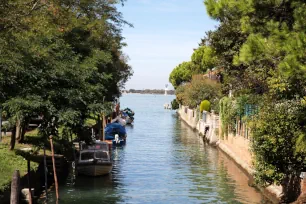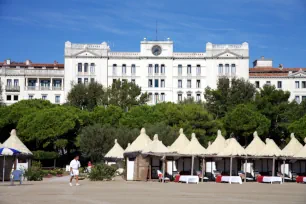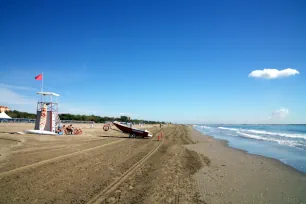Forming a barrier between Venice and the open sea, Lido’s exclusive hotels and wide beach continue to attract tourists. The island is also a fun place for locals to hang out during the warm months.
About Lido





Lido, which appropriately translates to ‘beach’ is a twelve kilometers long (7.5 miles) sandbar that is home to approximately 20,000 residents. As a summer playground, its population grows quite a bit during the summer months, when the luxury hotels fill up with Italian and foreign visitors. It is the only island in Venice where motorized traffic is allowed on the roads.
History
Historically, settlements on the island began in the center section of the sandbar, known as Malamocco. This portion of the sandbar served as an ancient port and today contains a few touristy places. Records also show that in 1202, thousands of Crusaders used Lido as a camp when they were detained there because they could not pay for passage to Venice.
The island only started to develop during the nineteenth century, when it became one of the first and most exclusive resorts in Europe, attracting famous writers, filmstars and even royalties. Grand hotels were built along the coastline, and the once almost deserted island became the place to be.
Film Festival
The island is known as the home of the annual Venice Film Festival, which takes place each September and attracts stars from around the globe, who come to view films of a number of different genres at the oldest film festival in the world. The festival started in 1932 and is still one of the world’s most important.
What’s there
On the northern part of the island, you’ll find the location of the film festival as well as several ritzy hotels, including the Grand Hotel Excelsior and the Grand Hotel des Bains. Up until recently, there was also a casino located on that portion of the island, but it has now closed.
On the side of Lido that faces the Adriatic Sea (the other side faces the lagoon), there are a number of private beaches that belong to hotels, as well as a few public beaches. Even at the private beaches, there’s always a nine-meter-wide strip near the sea open to the public. This area was the setting for Thomas Mann’s famous 1912 novel, Death in Venice.
For a good shopping experience, travel the Gran Viale Santa Maria Elisabetta which bisects the island beginning at the sea on one end and ending at the lagoon. Hotels, shops and restaurants line this wide street.
On the south end at the area known as Alberoni, visitors will find Venice’s only golf course. The course began as 9 holes in 1930 and was doubled to include 18 holes in 1950. The course is quite difficult technically.
Vaporetti connect Lido to Venice and the mainland as well as to the Marco Polo Airport. They run quite frequently so catching a ride is pretty easy.

